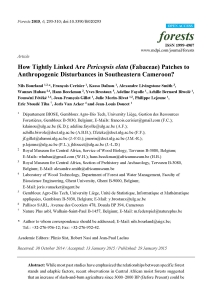Bourland N., Cerisier F., Daïnou K., Livingstone Smith A., Hubau W., Beeckman H., Brostaux Y., Fayolle A., Biwolé A.B., Fétéké F., Gillet J.F., Morin-Rivat J., Lejeune P., Ntoudé Tiba E., Van Acker J., Doucet J.L.
While most past studies have emphasized the relationships between specific forest stands and edaphic factors, recent observations in Central African moist forests suggested that an increase of slash-and-burn agriculture since 3000–2000 BP (Before Present) could be the main driver of the persistence of light-demanding tree species. In order to examine anthropogenic factors in the persistence of such populations, our study focused on Pericopsis elata, an endangered clustered timber species. We used a multidisciplinary approach comprised of botanical, anthracological and archaeobotanical investigations to compare P. elata patches with surrounding stands of mixed forest vegetation (“out-zones”). Charcoal samples were found in both zones, but were significantly more abundant in the soils of patches. Eleven groups of taxa were identified from the charcoals, most of them also present in the current vegetation. Potsherds were detected only inside P. elata patches and at different soil depths, suggesting a long human presence from at least 2150 to 195 BP, as revealed by our charcoal radiocarbon dating. We conclude that current P. elata patches most likely result from shifting cultivation that occurred ca. two centuries ago. The implications of our findings for the dynamics and management of light-demanding tree species are discussed.
Consultez la notice complète de l’article sur ORBi

